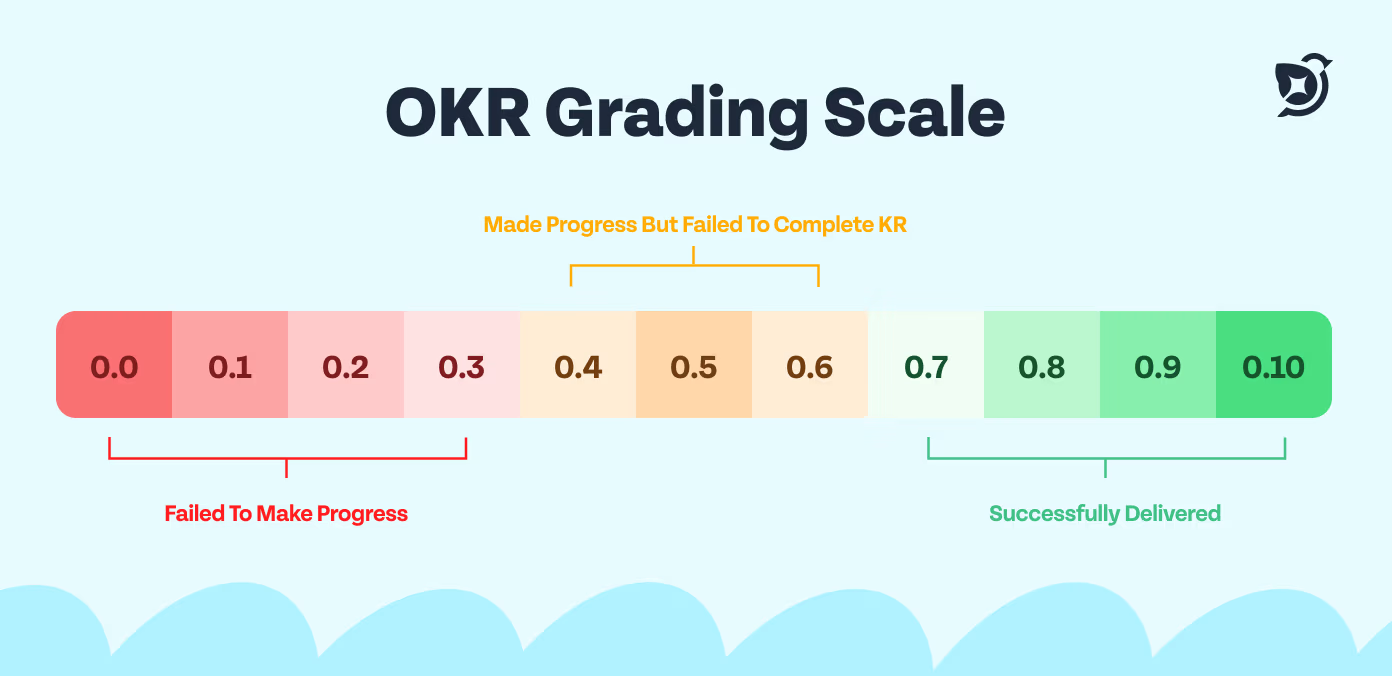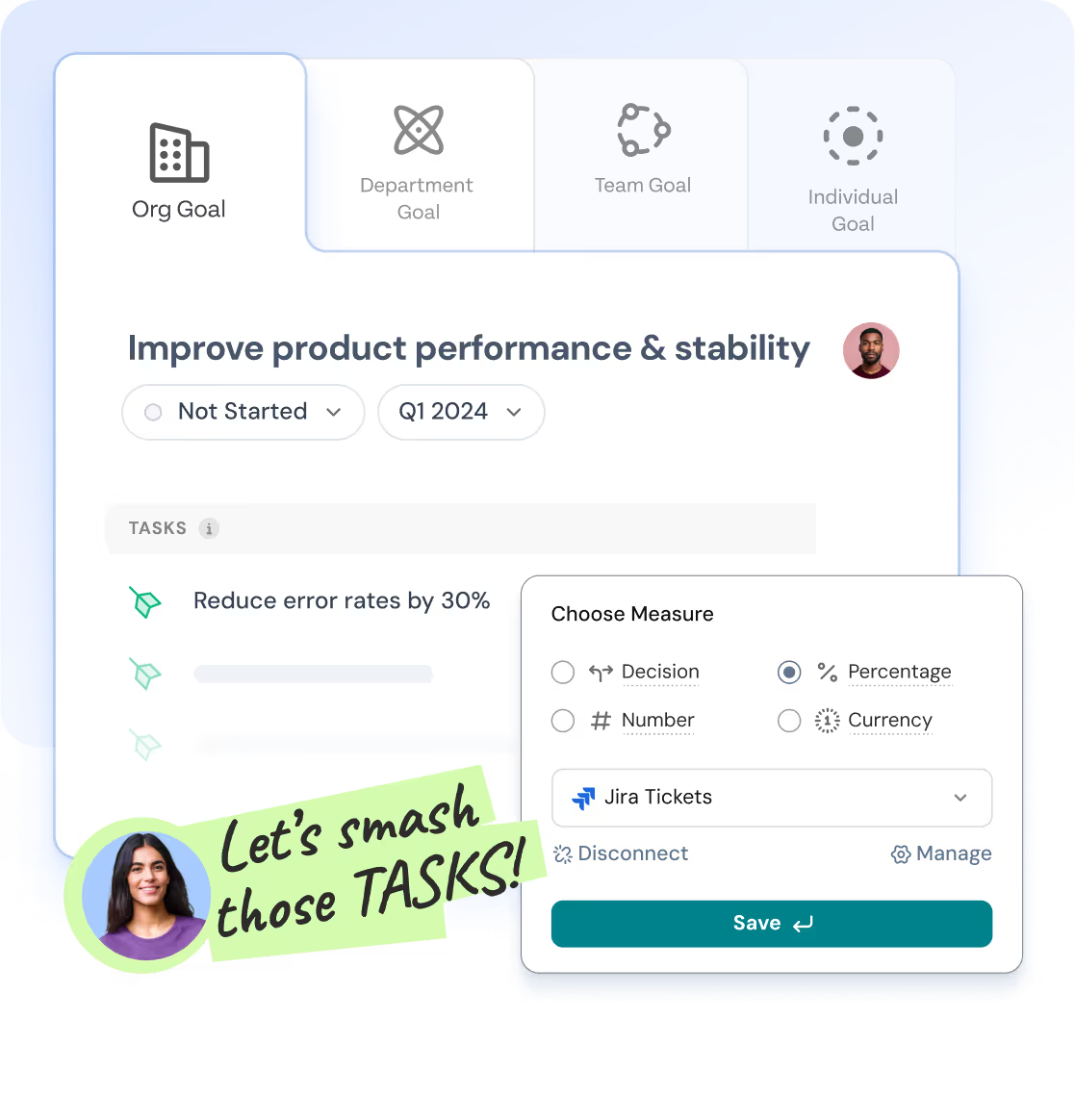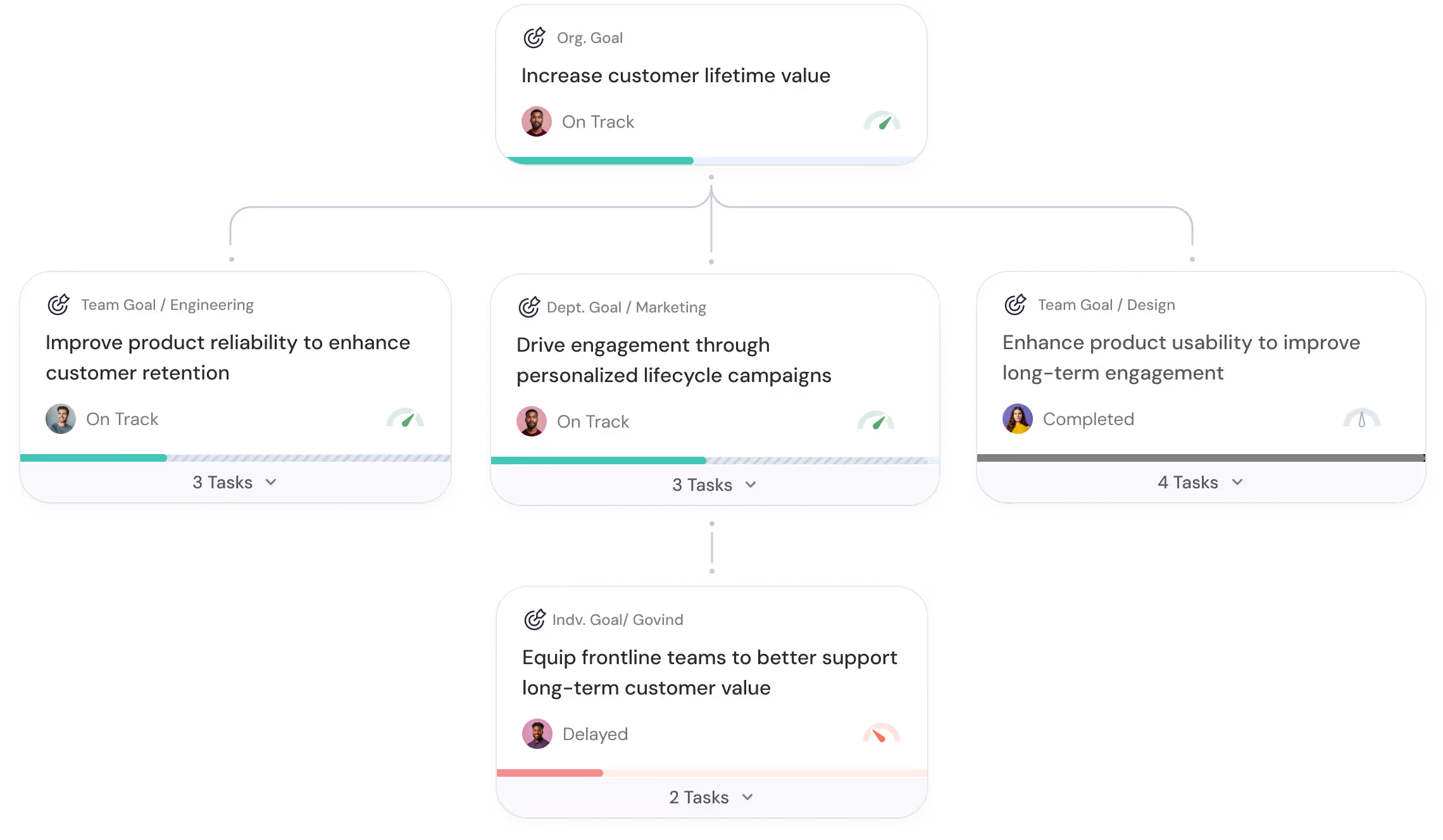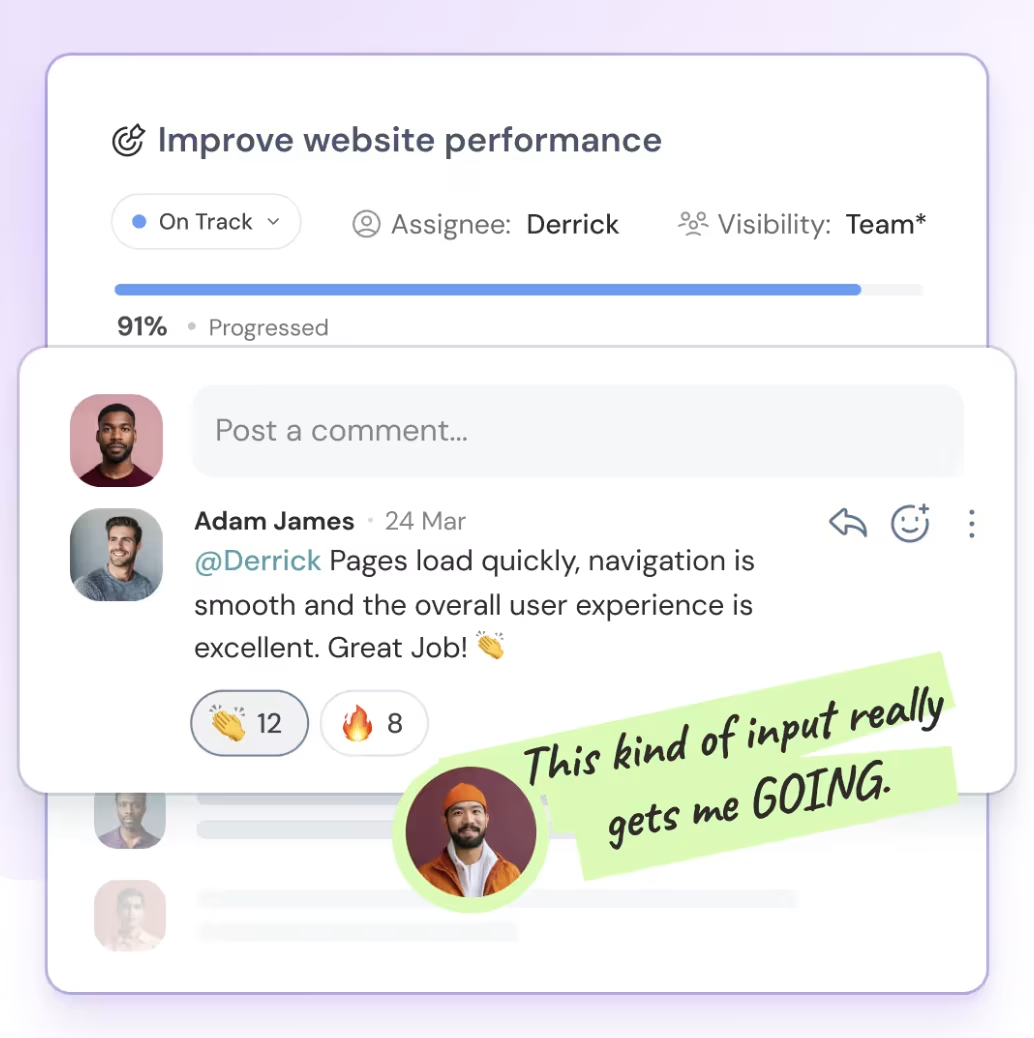Objectives and Key Results(OKRs)—are the backbone of high-performing organizations. They’re not just lofty goals written on whiteboards; they’re measurable commitments that help teams stay accountable, focused, and ambitious. But here’s the kicker: OKRs are only as good as the way you measure and score them. With scoring, organisations can transform OKRs into outcome-driven levers that sharpen execution, align teams, and fuel growth.
In this guide, we’ll break down proven OKR scoring frameworks, step-by-step methods to grade effectively, industry-specific examples, and best practices. We’ll also highlight how modern tools like ThriveSparrow Goals make the scoring process smarter and more scalable.
By the end, you’ll know exactly how to set, score, and sustain OKRs that move the needle.
Why Scoring Makes OKRs Work
Scoring transforms goals from aspirations into accountable outcomes, making it clear whether you’re on track, falling behind, or overshooting. Without a scoring framework, you’re left with vague statements that can’t be compared, tracked, or improved.
Think of OKR scoring like a car’s dashboard. The Objective is your destination. The Key Results are the milestones along the way. Scoring is the fuel gauge and GPS that tell you if you’re on track, running out of gas, or taking a wrong turn.
What are OKRs and Why Do They Matter?
OKRs consist of two parts:
- Objective → The qualitative, inspiring goal (the “what”).
- Key Results → The measurable outcomes that prove success (the “how”).
Example:
- Objective: “Become the market leader in employee experience solutions.”
- Key Results: “Win 5 new enterprise accounts” and “Increase NPS from 45 to 60.”
This structure ensures ambition (objective) is always tied to measurement (results).
But here’s the catch: without scoring, you can’t tell if moving from 45 NPS to 55 was a “win” or a “shortfall.” Scoring removes the ambiguity.
Common OKR Scoring Frameworks
Different organizations adopt different grading styles. The key is consistency across cycles—pick one that fits your culture and stick with it.
1. Binary Scoring (0 or 1)
Think of this as a pass/fail exam. Either you achieved the Key Result (1) or you didn’t (0).
Example:
- KR: “Launch the new company website by September 30.”
- Outcome: Website launched on September 28 → Score: 1
- Outcome: Website launched on October 5 → Score: 0
This method is perfect for yes/no deliverables.
2. Percentage Completion (0–100%)
The most intuitive framework—track progress in percentages.
Example:
- KR: “Hire 10 new engineers by Q4.”
- Outcome: Hired 7 engineers → Score: 70%
- Outcome: Hired all 10 → Score: 100%
It’s ideal for volume-driven goals like sales quotas, content production, or support tickets resolved.
👉Want more examples like this? Check out our guide on team goals examples.
3. Graded Scale (0.0–1.0 System)

Popularized by Google, this method uses a scale from 0.0 (no progress) to 1.0 (fully achieved). What’s unique here is the philosophy: a “good” score is 0.6–0.7, not 1.0. That means your goals were ambitious enough to push, but not unrealistic.
Example:
- KR: “Grow monthly active users from 5,000 to 10,000.”
- Outcome: Reached 8,000 → Score: 0.6
- Outcome: Reached 9,500 → Score: 0.9
This works especially well for companies undergoing big shifts, like those pursuing digital transformation goals.
4. Confidence Scoring for OKRs
Instead of waiting until the end of the quarter, teams regularly rate how confident they feel about hitting a KR. Scores range from 0 (no chance) to 10 (extremely confident).
Example:
- KR: “Launch iOS app in Q2.”
- Week 1: Confidence = 8/10 (on track).
- Week 5: Confidence = 4/10 (major dependency delays).
This system helps leaders spot red flags early and adjust resources before it’s too late. It’s especially useful in hierarchical organizations where alignment issues often slow progress—something we cover in our guide on hierarchy culture.
Step-by-Step Guide to OKR Scoring
Once you’ve chosen a scoring framework, the next challenge is applying it consistently across cycles. Think of this as a cycle(define, assign, interpret) that keeps your goals measurable, transparent, and actionable across teams.
Step1: Define Measurable Key Results
If you can’t measure it, you can’t score it. Many teams fall into the trap of writing vague Key Results that sound inspiring but can’t be quantified.
❌ Bad: “Improve customer satisfaction.”
✅ Good: “Increase NPS from 45 to 60 by Q4.”
Notice the difference? The second KR makes it possible to track progress, compare results, and set accountability.
Tools like ThriveSparrow Goals make this easier by letting you assign Key Results to numbers, percentages, currency. This ensures that every KR has a clear finish line and avoids subjective debates at the end of a cycle.

Try ThriveSparrow Goals free for 14 days — no credit card required.
Step2: Assign Scores to Outcomes
Once Key Results are measurable, you need to assign a score based on the outcome.
- Binary: Pass/fail (0 or 1). Great for clear deliverables like “Launch product by March 31.”
- Percentage: Actual ÷ Target × 100. Perfect for volume-driven metrics like “Close 100 deals” or “Hire 10 engineers.”
- Graded Scale: 0.0 (none), 0.3 (some progress), 0.7 (good progress), 1.0 (fully achieved). This approach balances ambition with learning.
Step3: Interpret Scores for Learning
Scoring is not the finish line—it’s the feedback loop. The real value comes from interpreting scores and using them to improve future goal-setting.
Example:
- 0.0–0.3 → Very little progress. Time to examine blockers, resources, or goal clarity.
- 0.4–0.6 → Moderate progress. The ambition was right, but execution fell short.
- 0.6–0.7 → The sweet spot. Bold goals paired with meaningful progress—this is where growth happens.
- 0.8–1.0 → Excellent results, but may indicate goals weren’t ambitious enough.
The key is to treat scores as learning signals, not judgment. A “low” score isn’t a failure—it’s insight into where priorities, resources, or processes need adjusting. A “high” score isn’t automatically a win—it may reveal that goals were set too conservatively.
When teams interpret scores together in retrospectives, they build a culture of transparency, alignment, and continuous improvement.
7 Best Practices for Scoring OKRs Effectively
To get the most from scoring, teams need more than just a framework—they need discipline and the right mindset. Follow these seven best practices to ensure OKR scoring drives real impact:
1. Avoid Vanity Metrics
Focus on impact, not appearances. Metrics like more sign-ups in a quarter may look impressive but often don’t reflect SaaS business growth. Instead, track meaningful indicators like MRR (Monthly Recurring Revenue), customer retention, NPS, or churn rate.
Example:
A SaaS company might hit 10,000 free trial sign-ups in a quarter. That sounds great, but if only 2% convert to paying customers, the real business impact is minimal. A better metric would be trial-to-paid conversion rate or customer lifetime value (CLV).
2. Set Ambitious yet Realistic Goals
On the 0–1 OKR grading scale, the sweet spot for scoring is 0.6–0.7.
Why? Because it shows your goals were ambitious enough to stretch the team, but not so unrealistic that they crushed morale.
- Scoring 1.0 every time? Your goals were too easy. That usually means sandbagging.
- Scoring 0.2 or less? The goals were too extreme and likely demotivating.
Hitting 0.6–0.7 on the 0–1 scale is the target. It means:
- You made significant progress toward a bold objective.
- There’s room for improvement and learning.
- The stretch created momentum and innovation without overwhelming the team.
Example:
KR: “Grow monthly active users from 5,000 → 10,000.”
- Ended at 8,000 → score = 0.6.
- Not perfect, but a meaningful leap that pushed growth.
3. Ensure Team Alignment
OKRs only work when everyone rows in the same direction. If individuals chase goals in isolation, you end up with silos and wasted effort.
That’s why OKRs should cascade through the organization:
- Individual OKRs → roll up into team OKRs
- Team OKRs → roll up into company-wide OKRs
With ThriveSparrow’s cascading visibility, everyone can see how their goals connect to the bigger picture, reducing silos and encouraging cross-functional collaboration.

Want to experience cascading visibility for OKRs? Try ThriveSparrow Goals free for 14 days — no credit card required.
4. Review Scores Regularly, Not Just Quarterly
Scoring should not be a “set-and-forget” exercise. Check in weekly or biweekly to update scores, discuss blockers, and adjust priorities.
For example, confidence scoring (0–10 ratings) allows leaders to intervene early when teams are slipping, instead of waiting until the end of the quarter.
5. Use Scores as Learning, Not Judgment
OKR scores are not performance reviews. They should never be tied directly to bonuses or promotions, because that encourages safe goal-setting. Instead, treat scores as learning signals:
- Low score? → Identify blockers or misaligned goals.
- High score? → Check if the bar was set too low.
This fosters a growth mindset where teams feel safe to aim high.
6. Pair Quantitative with Qualitative Insights
Numbers tell you what happened; context explains why it happened
Example:
A product team sets a Key Result: “Release 5 major feature updates in Q2.” By the end of the quarter, they only shipped 3 updates (60%).
On paper, the score looks like a miss. But here’s the context: during development, the team discovered critical security vulnerabilities that required immediate fixes. Instead of rushing features, they redirected effort to address these risks—protecting customers and ensuring platform stability.
Without the qualitative note, the OKR score just shows 60%. With the narrative, leadership understands it was a strategic trade-off that safeguarded the product’s credibility.
Encourage teams to add a short narrative to every scoring update. This way, OKR reviews become about insights and decisions, not just numbers.
7. Celebrate Progress, Not Just Results
A culture of OKRs thrives on recognition. Even if a KR lands at 0.6, acknowledge the work and learning behind it. Pair scoring reviews with moments of recognition using tools like ThriveSparrow Kudos, so employees feel valued for effort and growth—not just outcomes.

OKR Scoring Examples by Industry
1. Sales Example
- Objective: Expand enterprise revenue.
- KR: Close $2M in deals.
- Outcome: $1.5M → 0.75 score
2. Marketing Example
- Objective: Grow brand visibility.
- KR: Increase traffic from 30k to 50k.
- Outcome: 42k → 0.6 score
3. Product Example
- Objective: Improve reliability.
- KR: Reduce bug fix time from 10 days to 3.
- Outcome: 5 days → 0.7 score
4. HR Example
- Objective: Boost engagement.
- KR: Raise eNPS from 20 to 40.
- Outcome: 35 → 0.75 score
Tools for OKR Scoring
Scoring OKRs consistently isn’t just about frameworks—it’s about having the right tools. While small teams may start with spreadsheets, growing organizations quickly realize the need for purpose-built platforms. Here’s how the options stack up:
1. Spreadsheets (Google Sheets & Excel)
- Pros: Free, flexible, and easy to set up.
- Cons: Prone to version chaos, manual errors, and zero visibility across teams.
- Best for: Small teams or early-stage startups experimenting with OKRs. Works fine in the beginning, but collapses once teams start scaling.
2. Dedicated OKR Platforms (Weekdone, Ally.io, Lattice)
- Pros: Built-in scoring frameworks, reporting, and alignment views.
- Cons: Can feel rigid or overly complex, especially for smaller organizations.
- Best for: Mid-to-large companies that need structured OKR processes.
3. All-in-One Performance & Engagement Platforms (ThriveSparrow)
This is where ThriveSparrow Goals 2.0 goes beyond traditional OKR tools. It doesn’t just track numbers—it connects them to culture, engagement, and performance.
With ThriveSparrow, you get:
- Real-time dashboards → track progress at every level.
- Flexible scoring options → binary, %, 0–1 scale, or confidence-based.
- Cascading alignment → show how individual goals roll into team and company OKRs.
- AI nudges and insights → keep OKRs alive between reviews.
- Integration with feedback & recognition → tie goals directly to employee success.
Best for organizations that want OKRs to be more than metrics—a system that drives alignment, engagement, and accountability.
With ThriveSparrow Goals, scoring becomes effortless. Scores update automatically, dashboards give real-time visibility, and AI highlights keep teams accountable.
👉 Try ThriveSparrow Goals free for 14 days !
FAQs
1. How often should you score OKRs?
Quarterly is standard, but confidence scoring can be done weekly. Startups benefit from frequent reviews to stay agile.
2. Should OKR scoring affect employee bonuses?
No. Tying bonuses to OKRs kills ambition. Keep bonuses tied to performance reviews, not stretch goals.
3. What is a good OKR score?
0.6–0.7 is ideal. It means you stretched but didn’t fall flat.
4. How to handle partially achieved OKRs?
Score proportionally. If you reached 70% of target, your score is 0.7. Use the learning to adjust next cycle.
5. Can teams use different scoring systems?
Yes, but maintain a consistent overarching framework to avoid confusion.















